Picture books provide unique visual formats to support the literacy development of young and older readers, regardless of genre. In this column, we feature a Baker’s Dozen of recently published picture books that will engage and motivate students without breaking them into age groups. These books can be used at any reading level. The design elements of the selections coupled with creative storylines will delight all readers.
Ask Me. Bernard Waber. 2015. Ill. Suzy Lee. Boston. Houghton Mifflin Harcourt.
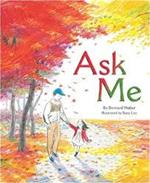 The simple and honest dialogue between a father and his daughter speaks volumes in this posthumous story by Bernard Waber. The endearing story begins with the young girl and her father taking a stroll through their neighborhood as she shares all of her “likes.” Suzy Lee’s illustrations add depth to the story’s message and accentuate the natural beauty of the outdoors. The contrasting hues and masterful use of lines add a visual dimension to the characters and setting. Each page celebrates the tender bond between parent and child with soft and colorful illustrations.
The simple and honest dialogue between a father and his daughter speaks volumes in this posthumous story by Bernard Waber. The endearing story begins with the young girl and her father taking a stroll through their neighborhood as she shares all of her “likes.” Suzy Lee’s illustrations add depth to the story’s message and accentuate the natural beauty of the outdoors. The contrasting hues and masterful use of lines add a visual dimension to the characters and setting. Each page celebrates the tender bond between parent and child with soft and colorful illustrations.
—MN
By Mouse and Frog. Deborah Fredman. 2015. Viking.
 An organized Mouse is ready to write her “brand-new” story when she is interrupted by her excited friend, Frog. As Mouse explains her idea for her project, Frog continues to add his creative ideas and inserts characters into what was supposed to be a serene story. Mouse slowly loses her patience and yells “Stop...the story is a mess!” With unique metafictive elements, the Frog turns to his cast of imaginary characters and explains that the story is “Mouse’s” and begins to erase them from the page. Sad and defeated, Frog allows Mouse to begin her story. When Mouse recognizes that there is room in her quiet story for Frog’s vivid imagination, she suggests that they collaborate. Deborah Freedman’s artistic blend of humor and visual ingenuity make this a wonderful book to read aloud.
An organized Mouse is ready to write her “brand-new” story when she is interrupted by her excited friend, Frog. As Mouse explains her idea for her project, Frog continues to add his creative ideas and inserts characters into what was supposed to be a serene story. Mouse slowly loses her patience and yells “Stop...the story is a mess!” With unique metafictive elements, the Frog turns to his cast of imaginary characters and explains that the story is “Mouse’s” and begins to erase them from the page. Sad and defeated, Frog allows Mouse to begin her story. When Mouse recognizes that there is room in her quiet story for Frog’s vivid imagination, she suggests that they collaborate. Deborah Freedman’s artistic blend of humor and visual ingenuity make this a wonderful book to read aloud.
—MN
Float. Daniel Miyares. 2015. Simon & Schuster.
 In this wordless picture book, a young boy learns how to make a paper boat. With great excitement, he takes it outside to play and pretends to sail the boat around his neighborhood. During a downpour, the boat floats in a puddle. Before long, the boat is out of reach as it floats through the sewer drain. At the bottom of the lake, he finds the remains of his boat unraveled into a piece of wet paper. Despondent and wet from the rain, he heads home and is quickly comforted by his dad. After a warm cup of hot chocolate, his dad shows him how to make a paper airplane. The young boy heads outside and watches his creation soar through the sky. The illustrations, perspective, angles, and lines add a rich visual dimension to this heartwarming story. The endpapers provide directions on how to make a paper boat and airplane. Bonus: When you remove the cover jacket, readers will find the image of the boat afloat in calm waters.
In this wordless picture book, a young boy learns how to make a paper boat. With great excitement, he takes it outside to play and pretends to sail the boat around his neighborhood. During a downpour, the boat floats in a puddle. Before long, the boat is out of reach as it floats through the sewer drain. At the bottom of the lake, he finds the remains of his boat unraveled into a piece of wet paper. Despondent and wet from the rain, he heads home and is quickly comforted by his dad. After a warm cup of hot chocolate, his dad shows him how to make a paper airplane. The young boy heads outside and watches his creation soar through the sky. The illustrations, perspective, angles, and lines add a rich visual dimension to this heartwarming story. The endpapers provide directions on how to make a paper boat and airplane. Bonus: When you remove the cover jacket, readers will find the image of the boat afloat in calm waters.
—MN
The Fly. Petr Horáček. 2015. Candlewick.
 The cursive writing on the cover of this book sets the tone for the seriousness of the fly’s perspective as conveyed in this story. As he explains, he’s a housefly “but people don’t like me being in houses.” Readers travel with the fly throughout his day as he is attacked by fly swatters, cow tails, and natural predators. Several pages feature die-cut fly swatters which, when combined with other clever elements of perspective and tone, make this book highly interactive and entertaining.
The cursive writing on the cover of this book sets the tone for the seriousness of the fly’s perspective as conveyed in this story. As he explains, he’s a housefly “but people don’t like me being in houses.” Readers travel with the fly throughout his day as he is attacked by fly swatters, cow tails, and natural predators. Several pages feature die-cut fly swatters which, when combined with other clever elements of perspective and tone, make this book highly interactive and entertaining.
—LC
Hippos Are Huge. Jonathan London. 2015. Ill. Matthew Trueman. Candlewick.
 From the up-close view of the inside of the hippo’s mouth on the cover to the images of their backsides with swatting tails and balls of dung, perspective plays a big role in this engaging piece of nonfiction for younger readers. In addition to the eye-catching illustrations, the book is full of surprising comparisons (“A hippo has the biggest mouth of any animal except for a whale”), high-interest facts, and fun details. The typography varies on each page, with onomatopoeias such as “glide” and “roar” in bold print and smaller font for some of the more informative text. The back includes an index and a brief “about hippopotamuses” section.
From the up-close view of the inside of the hippo’s mouth on the cover to the images of their backsides with swatting tails and balls of dung, perspective plays a big role in this engaging piece of nonfiction for younger readers. In addition to the eye-catching illustrations, the book is full of surprising comparisons (“A hippo has the biggest mouth of any animal except for a whale”), high-interest facts, and fun details. The typography varies on each page, with onomatopoeias such as “glide” and “roar” in bold print and smaller font for some of the more informative text. The back includes an index and a brief “about hippopotamuses” section.
—LC
I Don’t Like Koala. Sean Ferrell. 2015. Ill. Charles Santoso. Atheneum.
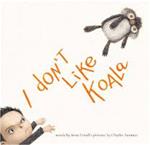 Who wouldn’t want to receive an adorable stuffed toy Koala as a gift? Well, not Adam, especially when the Koala has a creepy, crazed, piercing yellow eye. Adam tries to explain to his parents that he doesn’t like Koala, but they do not listen. So, Adam devises multiple plans to get rid of Koala. Readers will giggle at all of the different hiding places for Koala from under the sofa, behind a plant, in a saucepan, and in his mother’s purse to name a few. To no avail, Koala reappears on his bedside pillow and in a fit of rage, Adam throws Koala through the air again declaring, “I don’t like Koala.” The textured pencil illustrations, with muted colors, accentuate the varied expressions. The occasional comic book ‘panels’ and use of white space coupled with a humorous storyline will appeal to readers.
Who wouldn’t want to receive an adorable stuffed toy Koala as a gift? Well, not Adam, especially when the Koala has a creepy, crazed, piercing yellow eye. Adam tries to explain to his parents that he doesn’t like Koala, but they do not listen. So, Adam devises multiple plans to get rid of Koala. Readers will giggle at all of the different hiding places for Koala from under the sofa, behind a plant, in a saucepan, and in his mother’s purse to name a few. To no avail, Koala reappears on his bedside pillow and in a fit of rage, Adam throws Koala through the air again declaring, “I don’t like Koala.” The textured pencil illustrations, with muted colors, accentuate the varied expressions. The occasional comic book ‘panels’ and use of white space coupled with a humorous storyline will appeal to readers.
—MN
Inside This Book (Are Three Books). Barney Saltzberg. 2015. Abrams.
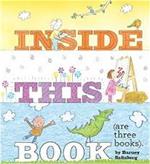 This clever and creative book celebrates the power of sharing stories and making books. Each book, created by three siblings (Seymour, Fiona, and Wilbur) supports their unique writing voice. The books vary in dimension, with three distinctive sizes (large, medium, and tiny). Seymour fills his book with observations, feelings, creative stories, and a comic strip. Fiona adds to her book by celebrating her love for poetry. Their little brother, Wilbur, is an emergent learner and, therefore, he draws pictures of their family and shares his love of dinosaurs. As part of the creative process, the three emerging authors decide to bind their unique books “inside” one book to share with others. The charming illustrations and design features may even inspire readers to explore bookmaking.
This clever and creative book celebrates the power of sharing stories and making books. Each book, created by three siblings (Seymour, Fiona, and Wilbur) supports their unique writing voice. The books vary in dimension, with three distinctive sizes (large, medium, and tiny). Seymour fills his book with observations, feelings, creative stories, and a comic strip. Fiona adds to her book by celebrating her love for poetry. Their little brother, Wilbur, is an emergent learner and, therefore, he draws pictures of their family and shares his love of dinosaurs. As part of the creative process, the three emerging authors decide to bind their unique books “inside” one book to share with others. The charming illustrations and design features may even inspire readers to explore bookmaking.
—MN
The Night World. Mordicai Gerstein. 2015. Little, Brown.
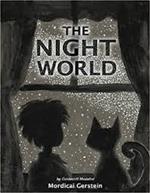 Sylvie, the cat, takes the red-headed protagonist in this book out to explore the dark of night. Sylvie starts meow-ing, then starts “me-out”ing. Her green eyes glow against the gray and black grain of the pictures as she leads the boy through the house and out into the front yard. Double-paged spreads of the house and yard capture the magic of the night as the boy questions why everything seems different. The white text is carefully placed to ensure readability until transitions to black when day breaks. An author’s note explains the night during his own childhood that inspired the story.
Sylvie, the cat, takes the red-headed protagonist in this book out to explore the dark of night. Sylvie starts meow-ing, then starts “me-out”ing. Her green eyes glow against the gray and black grain of the pictures as she leads the boy through the house and out into the front yard. Double-paged spreads of the house and yard capture the magic of the night as the boy questions why everything seems different. The white text is carefully placed to ensure readability until transitions to black when day breaks. An author’s note explains the night during his own childhood that inspired the story.
—LC
Outstanding in the Rain. Frank Viva. 2015. Little, Brown.
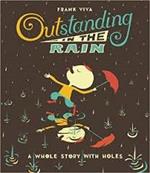 A young boy and his mother spend his birthday at Coney Island. The story unfolds in a series of rhyming oronyms, similar sounding phrases with different meanings, and die-cut illustrations. The cutouts reveal part of the phrase on one spread and the remaining part is unveiled on the next page. For example, the phrase “ice cream” transforms to “I scream.” Each page reveals superb artistic design, with die cuts, hand-drawn text type, and a corresponding color palette offering shades of red, yellow, brown, and teal. The book certainly measures up to its subtitle—“A Whole Story With Holes”—and will certainly invite readers to experiment with wordplay.
A young boy and his mother spend his birthday at Coney Island. The story unfolds in a series of rhyming oronyms, similar sounding phrases with different meanings, and die-cut illustrations. The cutouts reveal part of the phrase on one spread and the remaining part is unveiled on the next page. For example, the phrase “ice cream” transforms to “I scream.” Each page reveals superb artistic design, with die cuts, hand-drawn text type, and a corresponding color palette offering shades of red, yellow, brown, and teal. The book certainly measures up to its subtitle—“A Whole Story With Holes”—and will certainly invite readers to experiment with wordplay.
—MN
Please, Mr. Panda. Steve Antony. 2015. Scholastic.
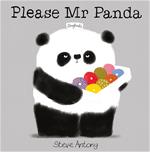 Holding a box of eight doughnuts against a gray background, it is hard to tell if the panda on the front of this book is friendly or grumpy. The plot involves the panda offering doughnuts to a variety of other black-and-white creatures, including a penguin and a skunk, but then refuses to share, saying, “I have changed my mind.” In the end, a lemur gets the box because he said “please.” Without a touch of didacticism, this book reminds readers of the importance of manners. The playful use of perspective and endpapers makes this a delightful read.
Holding a box of eight doughnuts against a gray background, it is hard to tell if the panda on the front of this book is friendly or grumpy. The plot involves the panda offering doughnuts to a variety of other black-and-white creatures, including a penguin and a skunk, but then refuses to share, saying, “I have changed my mind.” In the end, a lemur gets the box because he said “please.” Without a touch of didacticism, this book reminds readers of the importance of manners. The playful use of perspective and endpapers makes this a delightful read.
—LC
Sidewalk Flowers. JonArno Lawson. 2015. Ill. Sydney Smith. Groundwood.
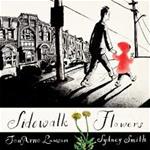 In this wordless picture book, readers meet a young girl and her father as they walk through the busy city streets toward their home. Through varied frames, the visual brilliance of tone, hue, and details abound on every page. Readers focus on the little girl’s vantage point as she spots two yellow-hued dandelions at the edge of the sidewalk. The flowers offer a brilliant ray of light and hope against the hurried city landscape. Her natural curiosity about her surrounding adds emotional significance. As she continues her walk, she gives away the flowers: she carefully places one flower into a dog’s collar and even leaves one in a sleeping man’s shoe. Perhaps one of the most poignant frames involves the father, immersed in his thoughts, walking right past a dead bird. The young girl lets go of her father’s hand, allowing her enough time to place a bouquet of flowers atop of the bird. The appearance of colors grows as the girl and her father near their home. Each frame signals the universality of warmth that individuals feel as they reunite with their loved ones. The young girl places flowers in her mother’s hair and even gives some to her siblings. The visual details coupled with an insightful story make this a must read. Learn the origin of the story here.
In this wordless picture book, readers meet a young girl and her father as they walk through the busy city streets toward their home. Through varied frames, the visual brilliance of tone, hue, and details abound on every page. Readers focus on the little girl’s vantage point as she spots two yellow-hued dandelions at the edge of the sidewalk. The flowers offer a brilliant ray of light and hope against the hurried city landscape. Her natural curiosity about her surrounding adds emotional significance. As she continues her walk, she gives away the flowers: she carefully places one flower into a dog’s collar and even leaves one in a sleeping man’s shoe. Perhaps one of the most poignant frames involves the father, immersed in his thoughts, walking right past a dead bird. The young girl lets go of her father’s hand, allowing her enough time to place a bouquet of flowers atop of the bird. The appearance of colors grows as the girl and her father near their home. Each frame signals the universality of warmth that individuals feel as they reunite with their loved ones. The young girl places flowers in her mother’s hair and even gives some to her siblings. The visual details coupled with an insightful story make this a must read. Learn the origin of the story here.
—MN
Spots in a Box. Helen Ward. 2015. Templar/Candlewick.
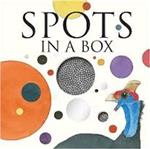 Through the use of whimsical text and detailed watercolor illustrations, Helen Ward’s picture book will intrigue readers. A guinea fowl did not have many spots, so he sends a note to “Please send spots,” which results in the arrival of a large package. Unfortunately, the spots were either too large, too tiny, or had “no spots at all” (as aptly illustrated with die-cut holes on the page). There were other spots that lit up and some were sparkly (with glitter accents on the page). There were even “connect the dot” spots and “spots of all sorts.” Finally, the persistent fowl discovers multicolored spots that match his personality. A perfect book for young readers.
Through the use of whimsical text and detailed watercolor illustrations, Helen Ward’s picture book will intrigue readers. A guinea fowl did not have many spots, so he sends a note to “Please send spots,” which results in the arrival of a large package. Unfortunately, the spots were either too large, too tiny, or had “no spots at all” (as aptly illustrated with die-cut holes on the page). There were other spots that lit up and some were sparkly (with glitter accents on the page). There were even “connect the dot” spots and “spots of all sorts.” Finally, the persistent fowl discovers multicolored spots that match his personality. A perfect book for young readers.
—MN
Templeton Gets His Wish. Greg Pizzoli. 2015. Disney Hyperion.
 Greg Pizzoli’s latest picture book features Templeton, an orange cat who wants his independence. He is annoyed at his parents and with his younger siblings. After reading an advertisement for a magic diamond that grants wishes, Templeton decides to “wish” his family away. His expression of sneakiness and sadness is set off by black background when he steals his brother’s piggy bank to get the money needed to buy the diamond. When he gets his delivery, he makes his wish, and his family disappears. Templeton is momentarily happy with his freedom until he does not like the feeling of being alone and wishes for their return. The bold color graphics of blue, bright green, orange, and black coupled with Pizzoli’s gift for adding unique character expressions will delight young readers. Bonus: Remove the cover jacket to reveal the image of the “box” that adds a creative visual dimension to this picture book.
Greg Pizzoli’s latest picture book features Templeton, an orange cat who wants his independence. He is annoyed at his parents and with his younger siblings. After reading an advertisement for a magic diamond that grants wishes, Templeton decides to “wish” his family away. His expression of sneakiness and sadness is set off by black background when he steals his brother’s piggy bank to get the money needed to buy the diamond. When he gets his delivery, he makes his wish, and his family disappears. Templeton is momentarily happy with his freedom until he does not like the feeling of being alone and wishes for their return. The bold color graphics of blue, bright green, orange, and black coupled with Pizzoli’s gift for adding unique character expressions will delight young readers. Bonus: Remove the cover jacket to reveal the image of the “box” that adds a creative visual dimension to this picture book.
—MN
Water Is Water. Miranda Paul. 2015. Ill. Jason Chin. Roaring Brook.
 The perfect blend of storybook and informational text, Water Is Water introduces young readers to the water cycle by following the seasonal adventures of two young children. A mixed-race family is featured, and a broader diverse community surround the two as they explore water, steam, ice, snow, and more. The soft-toned watercolor illustrations capture the beauty of all the phases of nature while the rhyming text pays homage to both the process and beauty of change. Ample back matter provides answers to further questions, additional facts, vocabulary, and source notes.
The perfect blend of storybook and informational text, Water Is Water introduces young readers to the water cycle by following the seasonal adventures of two young children. A mixed-race family is featured, and a broader diverse community surround the two as they explore water, steam, ice, snow, and more. The soft-toned watercolor illustrations capture the beauty of all the phases of nature while the rhyming text pays homage to both the process and beauty of change. Ample back matter provides answers to further questions, additional facts, vocabulary, and source notes.
—LC
Lesley Colabucci is an associate professor at Millersville University of Pennsylvania, where she teaches courses in children’s/adolescent literature. Mary Napoli is an associate professor of reading at Penn State Harrisburg, where she teaches literacy courses.
The review contributions are provided by members of the International Literacy Association’s Children’s Literature and Reading Special Interest Group.